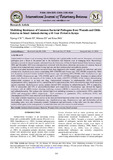| dc.contributor.author | Njoroge, C. W | |
| dc.contributor.author | Mande, J. D | |
| dc.contributor.author | Mitema, E. S | |
| dc.contributor.author | Kitaa, J. M. A. | |
| dc.date.accessioned | 2018-02-15T08:37:27Z | |
| dc.date.available | 2018-02-15T08:37:27Z | |
| dc.date.issued | 2017 | |
| dc.identifier.citation | Njoroge CW, JD Mande, ES Mitema and JMA Kitaa, 2016. Multidrug resistance of common bacterial pathogens from wounds and otitis externa in small animals during a 10 year period in Kenya. Inter J Vet Sci, 5(4): 262-267. www.ijvets.com | en_US |
| dc.identifier.issn | https://www.cabdirect.org/cabdirect/abstract/20173094120?q=(((%22university+of+nairobi+2017%22+OR+(university+of+nairobi+2017)))) | |
| dc.identifier.uri | http://hdl.handle.net/11295/103436 | |
| dc.description.abstract | Antimicrobial resistance is an increasing clinical challenge and a global public health concern. Emergence of resistant
pathogens pose a threat to the patient due to the limitations and financial costs in managing them. Bacteriology
laboratory records of clinical samples submitted from the University of Nairobi Small Animal Clinic between January
2004 and December 2013 were retrospectively reviewed with the aim to determine prevalence of common bacterial
isolates from wound and otitis externa of dogs and cats and their antimicrobial susceptibility profiles
The most prevalent bacterial isolates recovered from dogs diagnosed with wounds, surgical site infections and otitis
externa were: Staphylococcus aureus constituting 50% (140/280) and Proteus spp. 14% (40/280) respectively. Other
less frequently recovered isolates included Pseudomonas spp. constituting 10% (28/280), other Staphylococcus spp.
8.6% (24/280), Streptococcus spp. 7.5% (21/280) and E. coli 5.4% (15/280) respectively. Resistance to antimicrobial
agents was observed in the majority of the isolates in the study, with 97% (276/285) of the isolates demonstrating
antimicrobial resistance to at least one drug. Antimicrobial resistance to sulphonamides (95%), potentiated
sulphonamides (88%), ampicillin (67%), amoxicillin (62%) and tetracycline (56%) was relatively high for all bacterial
species examined. Staphylococcus aureus isolates showed 95% resistance to sulfamethoxazole, 55% to ampicillin,
52% to tetracycline and 52% to amoxicillin/clavulanic acid respectively. Pseudomonas spp. showed the highest
resistance with all (100%) isolates showing multidrug resistance (MDR) to amoxicillin, amoxicillin/clavulinic acid
and sulfamethoxazole. The isolates also showed high level multidrug resistance to cotrimoxazole (93%), ampicillin
(93%) and tetracyclines (80%) respectively. Low resistances to gentamicin (9%), norfloxacin (24%) and
chloramphenicol (33%) were observed in all bacterial isolates.
This study confirms Staphylococcus aureus as the most prevalent bacterial isolate from wounds and otitis externa in
small animals. Proteus spp., Pseudomonas spp., Staphylococcus spp., Streptococcus spp. and Escherichia coli in
descending order, were also commonly isolated. Gentamicin and norfloxacin, in that order were the most effective
antimicrobial agents in the management of wound infections and otitis externa in small animals. | en_US |
| dc.language.iso | en | en_US |
| dc.publisher | University of Nairobi | en_US |
| dc.rights | Attribution-NonCommercial-NoDerivs 3.0 United States | * |
| dc.rights.uri | http://creativecommons.org/licenses/by-nc-nd/3.0/us/ | * |
| dc.subject | Antimicrobial resistance, Bacteria, Wounds, Otitis externa, Small animals | en_US |
| dc.title | Multidrug resistance of common bacterial pathogens from wounds and otitis externa in small animals during a 10 year period in Kenya. | en_US |
| dc.type | Article | en_US |



